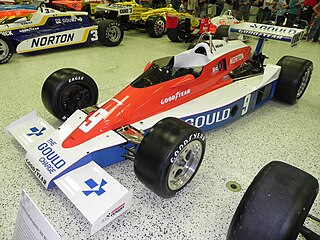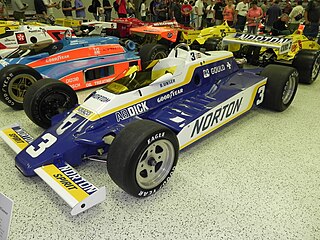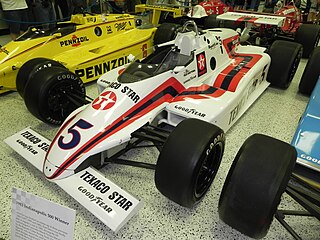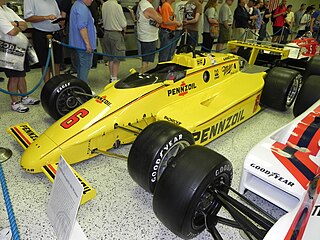
The 58th 500 Mile International Sweepstakes was held at the Indianapolis Motor Speedway in Speedway, Indiana on Sunday, May 26, 1974. Johnny Rutherford, in his eleventh attempt, won the race from the 25th starting position, the farthest back since Louis Meyer in 1936. It was the first of his three Indy victories, and started a three-year stretch where he finished 1st-2nd-1st.

The 60th 500 Mile International Sweepstakes was held at the Indianapolis Motor Speedway in Speedway, Indiana on Sunday, May 30, 1976. Polesitter Johnny Rutherford took the lead on lap 80, and was leading when rain halted the race on lap 103. Two hours later, the race was about to be resumed, but rain fell again. USAC officials called the race at that point, reverted the scoring back to the completion of lap 102, and Johnny Rutherford was declared the winner. Rutherford famously walked to Victory Lane, his second career Indy 500 triumph, having completed only 255 miles (410 km), the shortest official race on record. Janet Guthrie became the first female driver to enter the Indianapolis 500. However, her team was underfunded, and she experienced numerous mechanical and engine problems during the month. While she managed to pass her rookie test, and ran numerous practice laps in multiple cars, she was unable to make an attempt to qualify. She would return with a successful effort a year later in 1977.

The 61st 500 Mile International Sweepstakes was held at the Indianapolis Motor Speedway in Speedway, Indiana on Sunday, May 29, 1977. Considered one of the most historically significant editions of the Indianapolis 500, several sidebar stories complemented the unprecedented accomplishment of race winner A. J. Foyt. Foyt became the first driver to win the Indianapolis 500 four times. As of 2023, Foyt's record has been tied by Al Unser Sr., Rick Mears and Hélio Castroneves, but still stands as an Indy 500 record. Foyt's victory is also the last time the winning car was built entirely within the United States.

The 62nd 500 Mile International Sweepstakes was held at the Indianapolis Motor Speedway in Speedway, Indiana on Sunday, May 28, 1978. Danny Ongais dominated the early stages of the race but eventually dropped out with a blown engine. Al Unser Sr. dominated the second half, and held a large lead late in the race. However, Unser bent the front wing of his Lola during a pit stop on lap 180, causing his handling to go away over the final twenty laps. Second place Tom Sneva charged to catch Unser's crippled Lola but came up 8 seconds short at the finish line – the second-closest finish in Indy history to that point. Unser held off the challenge, and became a three-time winner of the 500. It was Al Unser's third Indy victory in the decade of the 1970s, and the fifth of nine overall victories by the Unser family.

The 63rd 500 Mile International Sweepstakes was held at the Indianapolis Motor Speedway in Speedway, Indiana, on Sunday May 27, 1979. Second-year driver Rick Mears took the lead for the final time with 18 laps to go, and won his first of four Indianapolis 500 races. It was also Mears' first of a record six Indy 500 pole positions. Brothers Al and Bobby Unser combined to lead 174 of the 200 laps, but Al dropped out around the midpoint, and Bobby slipped to 5th place at the finish nursing mechanical issues. It was also Roger Penske's second Indy 500 victory as a car owner.

The 64th 500 Mile International Sweepstakes was held at the Indianapolis Motor Speedway in Speedway, Indiana on Sunday, May 25, 1980. Johnny Rutherford won the pole position, led 118 laps, and won the race by a commanding 29.92 second margin. After failing to finish the race the year before, Jim Hall's radical new Chaparral 2K ground effects chassis was a heavy favorite entering the month, and drove a flawless race. Rutherford, the winner in 1974 and 1976, became the sixth driver to win the Indy 500 three times.

The 65th Indianapolis 500 was held at the Indianapolis Motor Speedway in Speedway, Indiana, on Sunday, May 24, 1981. The race is widely considered one of the most controversial races in Indy history. Bobby Unser took the checkered flag as the winner, with Mario Andretti finishing second. After the conclusion of the race, USAC officials ruled that Unser had passed cars illegally while exiting the pit area during a caution on lap 149. Unser was subsequently issued a one-position penalty. The next morning, the official race results were posted, and Unser was dropped to second place. Andretti was elevated to first place and declared the race winner.

The 67th Indianapolis 500 was held at the Indianapolis Motor Speedway in Speedway, Indiana, on Sunday, May 29, 1983. After finishing second three times, winning the pole position twice (1977–1978), and being the fastest qualifier one additional time (1981), Tom Sneva finally shook his "bridesmaid" status and won his first and only Indianapolis 500. The win also represented the record seventh Indy victory that chief mechanic George Bignotti was involved with.

The 75th Indianapolis 500 was held at the Indianapolis Motor Speedway in Speedway, Indiana, on Sunday, May 26, 1991. Rick Mears won from the pole position, becoming the third four-time winner of the Indy 500, joining A. J. Foyt and Al Unser. During time trials, Mears also established an Indy record by winning his sixth career pole position. The month of May for Mears was tumultuous, as he suffered his first ever crash at Indy since arriving as a rookie in 1977. The wreck during a practice run totaled his primary car, and broke a bone in his right foot. Mears kept the injury mostly secret, and later admitted that the pain he experienced during the race was so bad, he had to cross his legs in the car and push the accelerator pedal down with his left foot.

The 72nd Indianapolis 500 was held at the Indianapolis Motor Speedway in Speedway, Indiana, on Sunday May 29, 1988. Team Penske dominated the month, sweeping the top three starting positions with Rick Mears winning the pole position, Danny Sullivan at the center of the front row, and Al Unser, Sr. on the outside. Mears set a new track record, becoming the first driver to break the 220 mph barrier in time trials. On race day, the three Penske teammates proceeded to lead 192 of the 200 laps, with Rick Mears taking the checkered flag, his third-career Indy 500 victory. The race represented the milestone 50th victory in Championship car racing for owner Roger Penske and Penske Racing.

The 71st Indianapolis 500 was held at the Indianapolis Motor Speedway in Speedway, Indiana, on Sunday May 24, 1987. After dominating practice, qualifying, and most of the race, leader Mario Andretti slowed with mechanical problems with only 23 laps to go. Five laps later, Al Unser Sr. assumed the lead, and won his record-tying fourth Indianapolis 500 victory. At age 47, just days short of his 48th birthday, Unser became the oldest winner of the Indy 500, a record that still stands as of 2024. During the month of May, an unusually high 25 crashes occurred during practice and qualifying, with one driver in particular, Jim Crawford, suffering serious leg injuries.

The 68th Indianapolis 500 was held at the Indianapolis Motor Speedway in Speedway, Indiana on Sunday May 27, 1984. Rick Mears, who previously won in 1979, won his second Indy 500 victories driving for Penske. Contenders Tom Sneva and Mario Andretti dropped out of the race in the second half, leaving Mears alone two laps ahead of the field, and he cruised to the victory. Three months after the race, however, Mears would suffer severe leg injuries in a practice crash at Sanair.
The 1979 SCCA/CART Indy Car Series was the inaugural Championship Auto Racing Teams (CART) American open wheel racing championship series. The season consisted of 14 races. Rick Mears was the national champion, and the rookie of the year was Bill Alsup. The 1979 Indianapolis 500 was sanctioned by USAC, but counted towards the CART points championship. Rick Mears won the Indy 500, his first of four victories in the event.

The Pocono 500 was an IndyCar Series race held at Pocono Raceway in Long Pond, Pennsylvania, located in the Pocono Mountains. The first Indy car race at Pocono was held in 1971. It was the first major event held at the track, shortly after its completion. The race was sanctioned by USAC from 1971 to 1981, and then by CART from 1982 to 1989, and was known as the Pocono 500. The race was removed from the CART calendar following the 1989 running, due to poor track conditions, as well as poor revenue for the promoter.

The 1980 CART PPG Indy Car World Series season was the second in the CART era of U.S. open-wheel racing. It consisted of twelve races, beginning in Ontario, California on April 13 and concluding in Avondale, Arizona on November 8. The PPG Indy Car World Series Drivers' Champion and Indianapolis 500 winner was Johnny Rutherford. Rookie of the Year was Dennis Firestone. The entire season, including the 64th Indianapolis 500, was to be co-sanctioned by both the USAC and CART under the banner of the Championship Racing League (CRL). However, USAC withdrew from the arrangement after five races.

The 1975 Pocono 500, the 5th running of the event, was held at the Pocono Raceway in Long Pond, Pennsylvania, on Sunday, June 29, 1975. Branded as the 1975 Schaefer 500 for sponsorship reasons, A. J. Foyt became the first driver to win the Pocono 500 twice, with a rain-shortened victory.

The 1980 Pocono 500 was an IndyCar Series motor race held at the Pocono Raceway in Long Pond, Pennsylvania, on Sunday June 22, 1980. Branded as the 1980 True Value 500 for sponsorship reasons, it was the tenth running of the event. Bobby Unser won the race driving for Team Penske. It was Unser's first Pocono 500 win and the third for Penske.

The 1976 California 500, the seventh running of the event, was held at the Ontario Motor Speedway in Ontario, California, on Sunday, September 5, 1976. The event was race number 10 of 13 in the 1976 USAC Championship Car season. The race was won by Bobby Unser, becoming the first man to win the California 500 twice. The race was also the first Indy Car race for Rick Mears.

The 1977 California 500, the eighth running of the event, was held at the Ontario Motor Speedway in Ontario, California, on Sunday, September 4, 1977. The event was race number 12 of 14 in the 1977 USAC Championship Car season. The race was won by Al Unser, his first win in the California 500.

The 1978 California 500, the ninth running of the event, was held at the Ontario Motor Speedway in Ontario, California, on Sunday, September 3, 1978. The event was race number 13 of 18 in the 1978 USAC Championship Car season. The race was won by Al Unser, who became the only driver with win all three races in IndyCar's Triple Crown in one year.

















